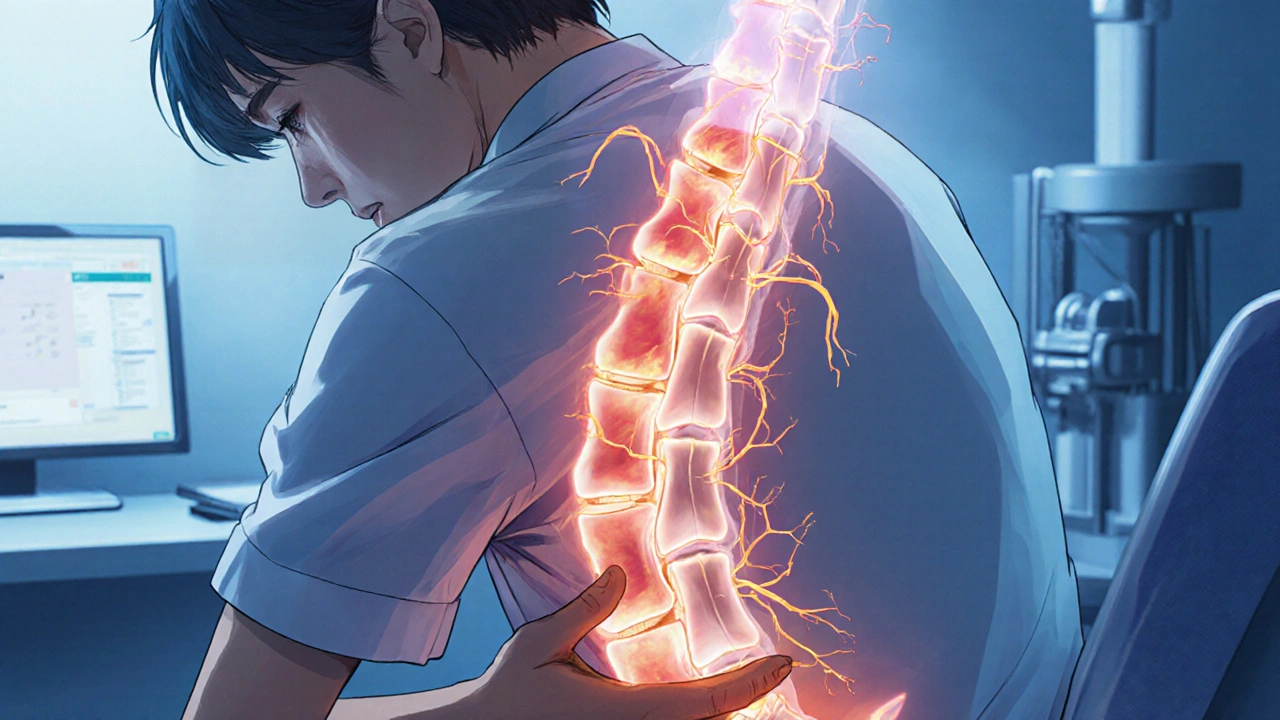Etodolac vs Other NSAIDs Comparison Tool
Compare Etodolac with other common NSAIDs to understand which medication might be best for your spinal stenosis pain management. Use the filters and sorting to focus on specific attributes important to you.
Filter by Attribute
| Attribute | Etodolac | Ibuprofen | Naproxen | Celecoxib |
|---|---|---|---|---|
| Typical dose for back pain | 300–400 mg twice daily | 400 mg three times daily | 250 mg twice daily | 200 mg once daily |
| COX-2 selectivity | moderate (partial) | low | low | high |
| Gastro-intestinal risk | moderate | high | moderate-high | low |
| Cardiovascular warning | similar to other NSAIDs | low | low | higher |
| Typical half-life | 6–7 hours | 2–4 hours | 12–17 hours | 11 hours |
Why these attributes matter:
Understanding the differences in dosing, selectivity, and side effect profiles helps you and your doctor make the best decision for your spinal stenosis pain management.
When the spinal canal narrows, the nerves inside can get squeezed, leading to chronic ache that makes everyday tasks feel like a marathon. Many patients wonder whether a prescription NSAID could calm that burning sensation without the side‑effects of stronger drugs. Below you’ll find a deep‑dive into why Etodolac is often considered a smart option for spinal stenosis‑related pain.
What is Etodolac?
Etodolac is a non‑steroidal anti‑inflammatory drug (NSAID) approved for the treatment of mild to moderate pain and inflammation. It belongs to the phenylacetyl‑pyridine class, which targets the cyclo‑oxygenase enzymes that produce prostaglandins - the chemicals that amplify pain signals and swelling. First launched in the United States in 1990, Etodolac has been used worldwide for conditions ranging from osteoarthritis to post‑operative discomfort.
Understanding Spinal Stenosis
Spinal stenosis describes a narrowing of the spaces within the spine, most commonly in the lumbar (lower back) region. The compression can affect the spinal cord or nerve roots, triggering lower‑back pain, leg cramps, and in severe cases, numbness or weakness. Age‑related degenerative changes, herniated discs, and thickened ligaments are typical culprits.
Why NSAIDs Matter for Spinal Stenosis Pain
The pain from spinal stenosis is largely driven by inflammation around the irritated nerves. NSAIDs step in by blocking the cyclo‑oxygenase (COX) enzymes - COX‑1 and COX‑2 - which are responsible for turning arachidonic acid into prostaglandins. By lowering prostaglandin levels, NSAIDs reduce both the intensity of pain and the swelling that worsens nerve compression.
How Etodolac Stands Out
- Longer half‑life: Etodolac’s half‑life (about 6-7 hours) means you often need only twice‑daily dosing, compared with three to four doses for ibuprofen.
- COX‑2 selectivity: While not as selective as celecoxib, Etodolac leans toward COX‑2 inhibition, offering good anti‑inflammatory action with a slightly lower risk of stomach irritation.
- Fewer central nervous system effects: Compared with opioid analgesics, Etodolac does not cause drowsiness or dependence, making it safer for long‑term use.
These traits make Etodolac a practical bridge between mild over‑the‑counter NSAIDs and stronger prescription options.

Typical Dosage for Back‑Related Pain
- Start with 300 mg taken twice daily with food.
- If pain persists after a week and no adverse effects appear, increase to 400 mg twice daily (maximum 800 mg per day).
- Maintain the lowest effective dose for the shortest period needed - usually 2-4 weeks for acute flare‑ups.
Always follow your clinician’s advice, especially if you have a history of ulcers, kidney disease, or cardiovascular concerns.
Safety Profile and Common Side Effects
Like all NSAIDs, Etodolac can cause gastrointestinal upset, mild headache, or dizziness. Serious but rare events include ulcer bleeding, elevated blood pressure, and kidney function decline. Mitigation strategies:
- Take the medication with meals or a glass of milk.
- Stay well‑hydrated and monitor blood pressure regularly.
- If you need long‑term therapy, discuss adding a proton‑pump inhibitor (e.g., omeprazole) to protect the stomach lining.
Etodolac vs. Other NSAIDs for Spinal Stenosis
| Attribute | Etodolac | Ibuprofen | Naproxen | Celecoxib |
|---|---|---|---|---|
| Typical dose for back pain | 300-400 mg twice daily | 400 mg three times daily | 250 mg twice daily | 200 mg once daily |
| COX‑2 selectivity | moderate (partial) | low | low | high |
| Gastro‑intestinal risk | moderate | high | moderate‑high | low |
| Cardiovascular warning | similar to other NSAIDs | low | low | higher |
| Typical half‑life | 6‑7 hours | 2‑4 hours | 12‑17 hours | 11 hours |
For patients who need twice‑daily dosing and want a balance between anti‑inflammatory power and gut safety, Etodolac often lands in the “sweet spot.” Naproxen offers a longer half‑life but can be harsher on the stomach, while celecoxib is gentler on the gut but carries a stronger cardiovascular warning.

Integrating Etodolac with Non‑Pharmacologic Therapies
Medication works best when paired with lifestyle tweaks. Physical therapy that emphasizes core strengthening, flexion‑based stretching, and posture training can relieve the mechanical pressure on the spinal canal. Hot or cold packs, low‑impact aerobic exercise (like swimming), and weight management further reduce inflammation.
When Etodolac Might Not Be the Right Choice
- History of peptic ulcer disease without protective medication.
- Severe kidney impairment (eGFR < 30 mL/min/1.73 m²).
- Uncontrolled hypertension or recent heart attack.
- Pregnancy, especially in the third trimester.
In these scenarios, doctors may prefer acetaminophen, topical NSAIDs, or non‑drug options such as epidural steroid injections.
Key Takeaways
- Etodolac reduces inflammation by partially blocking COX‑2, which lessens pain from nerve compression in spinal stenosis.
- Twice‑daily dosing offers convenience compared with many over‑the‑counter NSAIDs.
- Watch for gastrointestinal and kidney side effects; consider a protective proton‑pump inhibitor if therapy extends beyond a couple of weeks.
- Combine the drug with core‑strengthening exercises and weight control for the best long‑term outcome.
Can I take Etodolac with other NSAIDs?
Mixing Etodolac with another NSAID raises the risk of stomach bleeding and kidney strain. Stick to a single NSAID unless a doctor explicitly advises otherwise.
How fast will Etodolac relieve my back pain?
Most patients notice a reduction in aching within 24‑48 hours of the first dose, though full anti‑inflammatory effects may take up to a week.
Is Etodolac safe for long‑term use?
Long‑term use is possible if regular monitoring shows no stomach, kidney, or heart issues. Doctors usually limit continuous NSAID therapy to a few months.
What should I do if I miss a dose?
Take the missed tablet as soon as you remember, unless it’s almost time for the next dose. In that case, skip the missed one and resume your regular schedule - don’t double up.
Can Etodolac replace physical therapy?
No. Medication eases symptoms, but therapy addresses the underlying mechanical factors. The best outcomes come from using both together.

Gary Marks
October 22, 2025 AT 12:58Alright, let me lay it out in full color: Etodolac isn’t some miracle cure, but it does sit in that sweet spot between cheap over‑the‑counter pills and heavyweight prescription opioids, and that fact alone makes it worth a serious look. First, its half‑life of six to seven hours means you can dodge the nightmare of popping pills every few hours, which, honestly, is a relief for anyone who’s tried to juggle a schedule already packed to the brim. Secondly, the partial COX‑2 selectivity gives you a decent anti‑inflammatory punch while trimming down the typical stomach‑ache that comes with classic NSAIDs – a compromise that’s as close to perfect as pharmacology gets. The drug also avoids the drowsy, dependence‑forming trap that opioids gladly set for unsuspecting patients, so you won’t be nodding off at work or feeling like you need a daily dose just to feel normal. Sure, you still have to watch out for the usual culprits: gastrointestinal upset, a possible uptick in blood pressure, and kidney strain if you’re not careful, but those are manageable with food, regular monitoring, and maybe a proton‑pump inhibitor if the doc gives you the nod. In the grand scheme of spinal stenosis therapy, pairing Etodolac with core‑strengthening exercises, weight control, and a good physical therapist creates a holistic approach that attacks the problem from both chemical and mechanical angles. Think of it as a two‑pronged attack: the drug calms the inflamed nerves while your body gets stronger and less likely to compress those same nerves in the first place. If you’re hesitating because you’ve heard horror stories about NSAIDs, remember that every drug comes with a risk profile, and Etodolac’s risk‑to‑benefit ratio is actually pretty respectable when used responsibly. Bottom line: it’s not a magic bullet, but it’s a solid, practical option that deserves a place in the conversation, especially when you need something stronger than ibuprofen but less daunting than a narcotic. So, if your doctor gives you the green light, give it a try – just stay mindful of dosing, monitor side effects, and combine it with a solid rehab plan, and you’ll likely find the pain easing in a manageable, sustainable way.
Holly Green
October 23, 2025 AT 00:04Etodolac can be a handy middle ground for back pain, especially when you want fewer doses per day.
Jonathan Harmeling
October 23, 2025 AT 11:11While we’re all hunting for pain relief, it’s crucial to remember that relying solely on medication can mask the underlying issue. Etodolac offers anti‑inflammatory benefits, yet without the support of proper posture work and core strengthening, the relief may be fleeting. Balance is key, and that means pairing the drug with disciplined movement.
Vandermolen Willis
October 23, 2025 AT 22:18Totally agree, the dosing schedule is a lifesaver 🙌
Just don’t forget the stretches and the occasional swim session.
Craig E
October 24, 2025 AT 09:24From a philosophical standpoint, the trade‑off between efficacy and safety mirrors the classic ethical dilemma of means versus ends. Etodolac, occupying a median position, invites us to reflect on the prudence of moderate intervention rather than extreme measures.
Marrisa Moccasin
October 24, 2025 AT 14:58Interesting perspective, however, one must consider the hidden agendas of pharmaceutical corporations, the way they push certain NSAIDs, the way they downplay risks, the way they influence prescribers!!!
Caleb Clark
October 25, 2025 AT 00:41Okay, so listen up, because this is going to be a wild ride through the world of back pain meds and why Etodolac might just be your new best friend. First off, imagine you’re stuck in traffic for hours – that’s what chronic spinal stenosis feels like, a never‑ending grind that messes with every move you make. Now, picture Etodolac as that smooth‑running highway that lets you zip by the usual roadblocks, but it’s not a magic carpet, you still gotta keep your car in shape – meaning your core and posture need work too. The drug’s half‑life is like a trusty sidekick that shows up twice a day, so you’re not constantly nagged by a pill schedule that feels like a broken alarm clock. Plus, the COX‑2 lean‑iness means fewer stomach gremlins, which is a big win if you’ve ever felt like you were on a rollercoaster after taking ibuprofen. That said, you can’t ignore the fact that Etodolac still carries the familiar NSAID baggage – watch that blood pressure, keep an eye on your kidneys, and maybe pair it with a PPI if you’re in a long‑term marathon. I’ve seen patients who mix this with a solid physio regimen, and they’re back to gardening, hiking, and even dancing at family weddings without needing to pop pills every three hours. The key is balance: use the med to tame the inflammation, then let your therapist teach you how to strengthen the supportive muscles so the nerves stay out of the squeeze. Bottom line, it’s not a silver bullet, but it’s a reliable tool in the toolbox, especially when you want to keep the dosing simple and the side‑effects manageable. So, if your doc gives you the nod, give it a whirl – just remember the rest of the plan involves movement, hydration, and a little patience.
Eileen Peck
October 25, 2025 AT 04:51Great rundown! Just a heads‑up: some people report mild stomach upset even with Etodolac, so taking it with a big meal can help.
Steven Young
October 25, 2025 AT 13:11Etodolac is fine but don’t ignore the long‑term risks it carries.
Kelly Brammer
October 25, 2025 AT 21:31It’s essential to remember that medication should never replace responsible lifestyle choices. Etodolac can alleviate pain, but without proper exercise and weight management, the underlying stenosis remains.
Ben Collins
October 26, 2025 AT 04:51Oh sure, another “miracle” pill – because we’ve all solved our back problems by popping tablets, right?
Denver Bright
October 26, 2025 AT 10:24Funny how we’re told it’s safe, yet the pharma lobby quietly pushes the same drugs while ignoring alternative therapies.
cariletta jones
October 26, 2025 AT 17:21Stay positive, stay active, and consider Etodolac as a tool, not a crutch.
Kevin Hylant
October 27, 2025 AT 00:18Etodolac works quickly, and it’s important to follow the dosing schedule exactly.
Oliver Johnson
October 27, 2025 AT 07:14Look, the whole medical establishment wants you on pills, but Etodolac is just another pawn in the game. If you’re wise, you’ll use it sparingly and focus on real solutions, like strengthening your core and staying active, instead of becoming a glorified guinea pig.